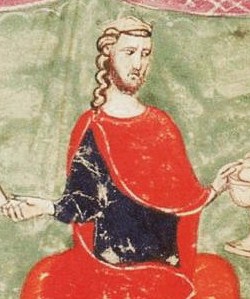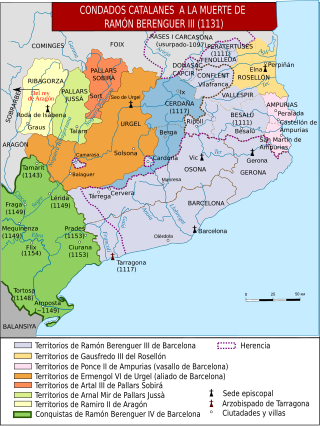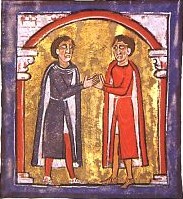Related Research Articles

Alfonso IV, called the Kind was King of Aragon and Count of Barcelona from 1327 to his death. His reign saw the incorporation of the County of Urgell, Duchy of Athens, and Duchy of Neopatria into the Crown of Aragon.

Peter III of Aragon was King of Aragon, King of Valencia, and Count of Barcelona from 1276 to his death. At the invitation of some rebels, he conquered the Kingdom of Sicily and became King of Sicily in 1282, pressing the claim of his wife, Constance II of Sicily, uniting the kingdom to the crown.

The County of Urgell is one of the historical Catalan counties, bordering on the counties of Pallars and Cerdanya.

Ramon Berenguer IIIthe Great was the count of Barcelona, Girona, and Ausona from 1086, Besalú from 1111, Cerdanya from 1117, and count of Provence in the Holy Roman Empire, from 1112, all until his death in Barcelona in 1131. As Ramon Berenguer I, he was Count of Provence in right of his wife.

This is a list of the counts of Urgell, a county of the Principality of Catalonia in the 10th through 13th centuries.
Ermengol or Armengol VIII (1158–1208), known as el de Sant Hilari was the count of Urgell from 1184 until his death. He was a son of Ermengol VII and Dulce, daughter of Roger III of Foix.
Aurembiaix (1196–1231) was the Countess of Urgell from 1208, the last of her dynasty.

Ermengol or Armengol VI, called el de Castilla, was the count of Urgell from 1102 until his death. He was the son and successor of Ermengol V and María Pérez, daughter of Count Pedro Ansúrez, Lord of Valladolid, who became the young Ermengol's tutor when he was orphaned in 1102.
Ermengol or Armengol V (1078–1102), called El de Mollerussa, was the count of Urgell from 1092 to his death. He was the son of Ermengol IV and his first wife, Lucy (Lucía) of Pallars.
Ermengol or Armengol IV (1056–1092), called el de Gerb or Gerp, was the count of Urgell from 1066 to his death. He was the son of Ermengol III and Adelaide.

Ermengol X (1254–1314) was the Count of Urgel and Viscount of Àger from 1268 to 1314. He was the son of Álvaro of Urgell and his second wife, Cecilia, daughter of Roger-Bernard II of Foix.

Álvaro, called Àlvar el Castellà in Catalan, was the Count of Urgell and Viscount of Àger from 1243. He was the son of Ponce I, Count of Urgell and succeeded his brother Ermengol IX within a year of their father's death.

Ermengol or Armengol III, called el de Barbastro, was the Count of Urgell from 1038 to his death. He was the son of Ermengol II, Count of Urgell and his wife Velasquita "Constança", probably the daughter of Bernard I, Count of Besalú.
Guerau IV de Cabrera (1196–1229) was a claimant to the County of Urgel during the time that James I of Aragon was King of Aragon. His uncle, Ponç III of Cabrera, married the daughter of Ermengol VII named Marquesa in 1194. Also, Marquesa’s father, Ermengol VII, was the son of Ermengol VI and his first wife, Arsenda of Cabrera. Through these familial ties to the House of Cabrera, Gerau came to claim the County of Urgell.

Bernard I, called Taillefer, was the Count of Besalú in Catalonia from 988 until his death. He was the eldest son of Oliba Cabreta and Ermengard of Empúries, and succeeded his father in Besalú while his younger brothers Oliba and Wifred, inherited Berga–Ripoll and Cerdagne–Conflent, respectively. He was the great-grandson of Wilfred the Hairy, and therefore belonged to the House of Barcelona.

ArnauMir was the Count of Pallars Jussà from 1124/6 until his death.
Ponce Giraldo de Cabrera, called Ponç Guerau in Catalan or Pons in Occitan, was a Catalan nobleman, courtier and military leader in the kingdoms of León and Castile.
Stephanie Alfonso of Castile was an illegitimate daughter of Alfonso VII of León and Castile and Urraca Fernández de Castro, widow of Count Rodrigo Martínez, who was Urraca's cousin or uncle. Her murder by her husband, Fernando Rodríguez de Castro, earned her the sobriquet Stephanie the Unfortunate.
William I was the Count of Forcalquier and Marquis of Provence from 1094. He was the second son of Count Ermengol IV of Urgell and the only son of Adelaide of Forcalquier, heiress of Count William Bertrand of Provence.
The Battle of Mollerussa took place in the south of the county of Urgell on 11 or 14 September 1102. In the battle, Count Ermengol V was defeated and killed by an Almoravid army. Mollerussa lies halfway between Bellpuig and Lleida and is the largest town in the Pla d'Urgell.
References
- ↑ Lomax, DW (1982). "Catalans in the Leonese Empire". Bulletin of Hispanic Studies (Liverpool).